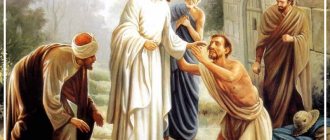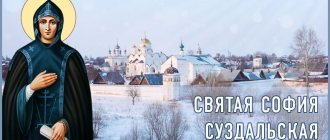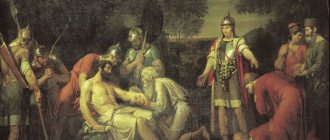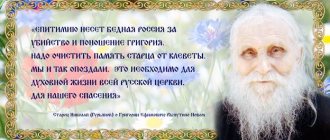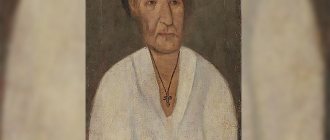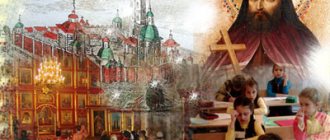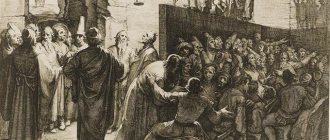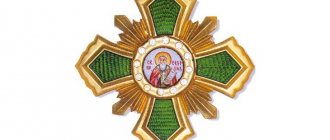Topic 6. Holiness in the world: the faithful, the holy fools, the righteous
Christians who have lived piously in the world, but are not among the faithful or holy fools, are usually canonized as righteous
(righteous Job the Long-Suffering, righteous Simeon the God-Receiver, Joachim and Anna, righteous Juliania of Lazarevskaya, righteous Theodore Ushakov, righteous John the Russian, righteous John of Kronstadt).
Considering the lives of Byzantine lay saints, one can identify several paths to holiness, several types of exploits in the world.
First of all, it is abundant alms
.
The virtue of mercy, acquired through the giving of material
alms, is, according to the teaching of the holy fathers, primarily an attribute of the feat of piety in the world.
A monk who has taken a vow of non-covetousness and “has nothing on earth” is “not given the obligation to give alms.” “But whoever is busy with everyday affairs, works with his own hands and takes from others himself, is obliged to give alms” (St. Isaac the Syrian. Sermon 14) 869. Such a famous saint as Philaret the Merciful . 870
History of St.
Peter the Publican
testifies that alms, even given with anger, can justify a person before God.
It is interesting that the life of this saint was written by Saint John the Merciful ,
Patriarch of Alexandria (November 12, Art.), who himself became famous for his extraordinary generosity and mercy.
See Appendix to Topic 6.
One of the components of mercy towards one's neighbor is selfless service to the sick. For the feat of providing free medical care, Christians are glorified as unmercenary
(unpaid doctors).
Healing bodily illnesses, the holy unmercenaries exhorted the suffering to lead a virtuous life, and converted unbelievers to Christ. The success of their medical art was a matter of God's grace. The holy healers knew this and therefore did not take rewards for their labors according to the Savior’s commandment: “Tune thou eat, thou shalt give.”
(Matthew 10:8). Through love for their neighbors, they expressed their love for God and worked to glorify the name of the Lord, who gave them the power to heal ailments. God often crowned the virtuous life of free healers with martyrdom.
The most famous unmercenary saints are the Cosmas
and
Damian of Assia
(November 1, Art.), who lived in Asia Minor no later than the 4th century. Such a case testifies to their non-acquisitiveness. The woman healed by the holy brothers secretly persuaded Damian, conjuring him by God, to take three eggs as a reward in the name of the Holy Trinity. Saint Cosmas, having learned about this, bequeathed not to bury him with Damian. But when both brothers died in peace, God miraculously announced that they should be buried together, because Damian took the gift not as a reward, but for the sake of the name of God.
The Church venerates two more pairs of holy unmercenary brothers with the same names: Cosmas
and
Damian of Rome
(July 1, Old Art.) and
Cosmas
and
Damian of Arabia (Cilicia)
(October 17, Old Art.).
Cosma
and
Damian of Rome
lived in the 3rd century. They are glorified as martyrs, although their death was the death of passion-bearers. The holy brothers confessed loyalty to Christ during persecution during interrogation by the emperor. Karina (283–285), were released with honor after the emperor was healed of a sudden illness and were soon killed out of envy by their teacher, a doctor (he called them to the mountains to collect medicinal herbs and stoned first one, then the other).
About Cosmas and Damian of Arabia
Very little is known: that they came from Arabia, that they were skilled doctors, but they healed not so much with their skill as with the power of Christ and became famous everywhere for their teaching and miracles. The brothers were executed for professing Christianity at the end of the 3rd century under Diocletian and Maximian and were glorified by the Church as martyrs and unpaid doctors.
Another pair of holy doctors - unmercenaries - is Cyrus
and
John
(January 31, Old Art.).
Saint Cyrus was a famous physician in Alexandria. During the persecution of Diocletian (284–305), he retired to the Arabian desert, where he accepted monasticism, and continued to heal people there with his prayer. Warrior John
Having heard about Saint Cyrus, he came to Arabia and became his faithful follower. In Egypt, in the city of Kanop, a Christian woman, Athanasia, was captured with three young daughters, 15 years old, 13 years old and 11 years old. Saints Cyrus and John, fearing that fear of torment might force them to renounce Christ, visited the confessors in prison in order to strengthen them for the upcoming feat. The ruler of the city captured Saints Cyrus and John and tortured them in front of Athanasia and her daughters. The confessors also bravely endured all the torment and were beheaded. Following them, the unmercenary saints Cyrus and John †311 were executed in the same place.
Demanding only faith in Christ as a reward, the great martyr and healer Panteleimon
and
the martyrs
Tryphon
and
Orestes of Tainsky .
Sampson the Stranger was glorified for his feat of Christian charity towards the sick and suffering.
(June 27/July 10). He lived under the emperor. Justinian, was from a wealthy Roman family, received a good education, studied the art of medicine especially thoroughly, and studied it with only one purpose - to serve his neighbor. After the death of his parents, Sampson distributed the inheritance to those in need, set all the slaves free and went into the desert. However, God soon called him to another feat: he settled in a small house in Constantinople and began to receive strangers, the sick, and the poor. When Sampson healed Emperor Justinian (527–565) from a serious illness, he, refusing rich gifts, asked to build a hospice house with a hospital. The emperor complied with the saint's request and assigned these institutions the necessary maintenance. The saint reposed painlessly at a ripe old age, ca. 530, many sick people flocked to his tomb in the hope of his intercession before the Lord.
Service of St. Sampson was repeated in the 20th century by the holy martyr Grand Duchess Elizabeth
,
who founded the Martha and Mary Convent in Moscow, which had a free hospital, an orphanage, courses for sisters of mercy, a library, etc. Caring for the sick, caring for the poor and homeless in the monastery were combined with edifying them in faith and virtue.
Another feat of a layman is the Orthodox upbringing of children, which, of course, is unthinkable without personal piety. Christians are glorified among the saints, who gave the world great saints, martyrs, and saints.
Let's remember their names. This is the mother of St. Gregory the Theologian St. Nonna
;
Grandmother of St. Basil the Great St. Macrina
(confessor of the faith) and his mother
Emilia ;
mother of St.
Grigory Dvoeslova Sylvia
;
blzh. Monica ,
mother of the blessed one.
Augustine; mother of St. Simeon of Divnogorets St. Marfa
;
mother of the military Panteleimon St. Evvula ;
parents of the martyr Konon, contemporaries of the apostles
Nada
and
Nestor
;
mother of the unmercenary saints Cosmas and Damian of Assia, Theodotius ;
parents of St. Sergius of Radonezh,
Kirill
and
Maria
.
The Holy Fathers attach great importance to the upbringing of children in the spirit of Christianity, placing this work of the layman in direct connection with his own salvation. “If the children born by you receive a proper upbringing and, through your care, are taught in virtue,” writes St. John Chrysostom, “then this will be the beginning and foundation of your salvation, and, in addition to the reward for your own good deeds, you will receive a great reward for their upbringing” 871. “What an inexplicable grief,” says St. Ignatius Brianchaninov, - at the Last Judgment of Christ will embrace those parents who will be angrily and threateningly denounced and condemned by the impartial Judge for sacrificing their children to the ruler of the world! What incomparable joy will embrace those parents whom this Judge will bless and praise for sacrificing their children to God, for preparing them to become residents of a bright paradise!” 872.
A parental feat of special strength and gravity is to beg for their children who have fallen away from the faith and are leading a sinful life. We see an example of this feat in the life path of the blessed one. Monica
, mother of the blessed
Augustine .
As you know, blzh. Before his baptism at the age of 33, Augustine led a licentious, sinful life and was carried away by non-Christian and heretical teachings. And all this time blzh. Monica never stopped praying for him. The answer of St. is known. Ambrose of Milan, who saw her grief and prayerful works: “A child of so many tears cannot perish.” And her son did not die. He received Holy Baptism and then worked for the good of the Church for about 43 years. A reminder of the feat of the blessed one. We meet Monikas among Russian saints of the 19th century, in letters addressed to mothers grieving over the unbelief of their children. “Remember from what depths of evil Blessed Augustine was rescued by the prayer of his pious mother,” reminds St. Ambrose of Optina 873. “Remember the mother of Blessed Augustine,” writes St. Theophan the Recluse. “I cried and cried, prayed and prayed!” And she begged and cried that Augustine came to his senses - and began to act as he should” 874.
Among the lay saints, whose names are in the Slavic printed calendar, there are pious warriors:
John the Warrior
and
Michael the Bulgarian warrior.
John the Warrior was discussed in the section devoted to the history of the persecution of Christians.
His feat is close to the feat of the confessors (under Julian he was imprisoned for secretly helping Christians, and after the death of the emperor he lived the rest of his life purely and fearing God). But in the life path of another warrior - Mikhail Bolgarin ,
new features of holiness, characteristic of military service, appear with all clarity: valor in battle, strengthened by faith and trust in God, and protection of citizens in times of peace.
See Appendix to Topic 6.
The list of lay saints includes deaconesses: a contemporary of St. John Chrysostom Olympiad Tsaregradskaya
(†410),
Poplia of Antioch
(lived under Julian the Apostate, 4th century) and
Theozva ,
sister of St. Gregory of Nyssa (IV century).
The path to holiness of this group of lay saints is directly related to their ministry. Pious virgins and widows at least 40 years of age were elected to deaconesses, after a very careful examination of their lives. Deaconesses belonged to the clergy and were appointed to their service by prayer with the laying on of hands by the bishop (ordination). Although deaconesses were not nuns, they took a strict vow of celibacy, which they had to maintain until their death. The duties of deaconesses included preparing women for Baptism, assisting the priest in performing the Sacraments over them, visiting women’s homes for edification, etc., that is, they served as intermediaries between women and clergy 875. Holy deaconesses are also known for their works of mercy - abundant alms, zealous care about the disadvantaged, the sick, the wanderers. The path to holiness for the deaconess, thus, combined two feats - the feat of a monk with his vow of celibacy, with complete devotion to God and the Church, and the feat of a layman who devoted himself to the “external” service of mercy, “material alms.” For widowed deaconesses, another “worldly” feat is added, another mandatory condition for entering the ministry of deaconess - pious marriage (and raising children) in a single marriage. See Appendix to Topic 6.
Analysis of the lives of Russian saints gives us several more types of feat in the world. One of them is called by G. Fedotov social simplification
.
This is how St. was saved. Simeon of Verkhoturye
(†1642).
Such is the feat of the locally revered saint of Siberian rights. Theodore of Tomsk ,
known under the name of “elder Fedor Kuzmich”.
See Appendix to Topic 6.
Another wonderful example of holiness in the world is St. right Juliania Lazarevskaya
(†1604), mother of many children, prayer worker and faster, known for her extraordinary mercy towards those in need.
The humble beauty of the feat of righteous Juliana shows how deeply the Gospel could enter the life of ancient Russian man and transform his entire personality. Although Juliana went through severe asceticism and dreamed of monasticism, she nevertheless remained faithful to her Christian calling - the service of active Christian love. See Appendix to Topic 6.
The feat of holiness of priests 876 is a continuation of their daily pastoral service, bringing it to complete self-denial, this is a feat of love for their flock and imitation of Christ in this. Pastoral service takes place in a world where, unlike a monastery, the priest is surrounded not only by like-minded people who have dedicated their lives to Christ, but by a variety of people: lukewarm and zealous, experienced and neophytes, believers and non-believers. The life of a priest takes place in a variety of everyday concerns, in which he must maintain a prayerful attitude and a peaceful spirit.
In these difficult conditions, the shepherd leads the spiritual sheep to Christ, protects them, nourishes them and prayerfully stands for them. Pastoral activity itself combines clergy, missionary work, and often confession.
The famous shepherd, preacher and miracle worker is right. John of Kronstadt
(1829–1908, commemorated December 20, Old Art.) It was not for nothing that people called him “All-Russian Father.” His pastoral ministry, in addition to his daily presence before the Throne, consisted of numerous and successful charitable enterprises. After his ordination, Father John begins tirelessly preaching in church and in private homes, teaches at the gymnasium, and establishes the “House of Diligence” for the poor in Kronstadt, the “John the Baptist Brotherhood of Sobriety.” He founded a women's monastic community, which was later transformed into the Sursky St. John the Theological Convent. The fame of him as a famous shepherd and miracle worker spread throughout the Russian land, and tens of thousands of pilgrims flocked to Kronstadt.
Almost every day, Father John celebrated the Divine Liturgy, calling on his flock to partake of the Holy Mysteries of Christ as often as possible. His name became known and respected in the Orthodox world also thanks to the publication of his spiritual diaries (his book “My Life in Christ” is most famous). St. rights John of Kronstadt was canonized in 1990.
Another famous Moscow shepherd, holy righteous Alexy (Mechev)
(1859–1923, commemorated June 9, Old Art.) labored in the center of Moscow, in the Church of St. Nicholas in Klenniki. Having gone through the experience of serving as a psalm-reader in the Znamenskaya Church of the Prechistensky Deanery, where he was often treated very rudely, Fr. Alexy was ordained and began his ministry at St. Nicholas Church, where at that time there was a very small parish. He introduced daily worship and served for 8 years in an empty church almost alone. But gradually, mourning people and burdened with sorrows flocked to this temple, and from them the rumor spread about its kind abbot. Father Alexy had the gift of foresight, which he combined with humility and meekness. Having experienced personal grief associated with the death of his beloved wife, he received the grace and experience of consoling everyone who came to him with their troubles and everyday problems. He contributed to the revival of ancient Russian icon painting, blessing his spiritual daughter Maria Nikolaevna Sokolova (later nun Juliana) to paint icons. The true spiritual friends of Father Alexy were the Optina elders, Hieroschemamonk St. Anatoly (Potapov), abbot Feodosius. The holy righteous Alexy Mechev was glorified at the Council of Bishops in 2000.
Jonah (Atamansky) was also canonized.
(1855–1924, commemorated May 17, Old Style), rector of the port St. Nicholas Church in Odessa. His spiritual life was so high that the Kyiv ascetics of that time said about him, a white priest with children and grandchildren: “We, monks, are not worth him.” When believers from Odessa came to the holy righteous John of Kronstadt, he told them: “Why are you bothering to come to me? You have your own John of Kronstadt - Father Jonah." In Odessa they call him “a man of legend.”
Service Fr. Jonah fell on a difficult time - the Russian-Japanese War, the uprising on the battleship Potemkin, the revolution, the Civil War, the autocephalous and renovationist schisms, persecution of the Church. At this time, the righteous Jonah performed miracles worthy of the ancient saints: he cast out demons, healed the sick, and in an incomprehensible way appeared outside the body in the Annunciation Monastery near Odessa, predicting the martyrdom of 200 sisters of this monastery. For his struggle with the spirits of evil, he suffered severe sorrows and discord in the family, misfortunes with children 877.
Odessa sailors tried not to go to sea without the blessing of Fr. Ions. In 1905, during a mutiny on the battleship Potemkin, Prot. Jonah persuaded the city authorities to allow the funeral of the instigator of the uprising, sailor G. Valenchuk, which prevented further shelling of the city and the Transfiguration Cathedral from the ship’s onboard guns.
During the period of the propagation of renovationism by the authorities, the church where Archpriest served. Jonah, was the only Orthodox church in the city. During the campaign to liquidate church property, Fr. Jonah was arrested, but was released at the request of the townspeople and soon died from a serious illness. On his final journey, despite the opposition of the authorities, huge crowds of people accompanied him 878.
Prot. Jonah Atamansky was canonized in 1996 by the decision of the Synod of the Ukrainian Orthodox Church of the Moscow Patriarchate.
These shepherds showed the world an example of humility and love and led countless people to Christ. They achieved personal holiness in serving people and complete self-denial. Their lives show how it is possible to please God in the world and achieve holiness through caring for others and worldly activities, if it is accompanied by prayer and true love for others.
Metropolitan Kirill about Alexander Nevsky - the name of Russia
On October 5, 2008, in a television program dedicated to Alexander Nevsky, Metropolitan Kirill gave a fiery 10-minute speech in which he tried to reveal this image so that it would become accessible to a wide audience. The Metropolitan began with questions: why could a noble prince from the distant past, from the 13th century, become the name of Russia? What do we know about him? Answering these questions, the Metropolitan compares Alexander Nevsky with the other twelve contenders: “You need to know history very well and you need to feel history in order to understand the modernity of this man...
I looked carefully at everyone's names. Each of the candidates is a representative of his workshop: politician, scientist, writer, poet, economist... Alexander Nevsky was not a representative of the workshop, because he was at the same time the greatest strategist... a person who sensed not political, but civilizational dangers for Russia. He did not fight against specific enemies, not against the East or the West. He fought for national identity, for national self-understanding. Without him there would be no Russia, no Russians, no our civilizational code ."
According to Metropolitan Kirill, Alexander Nevsky was a politician who defended Russia with “very subtle and courageous diplomacy.” He understood that it was impossible at that moment to defeat the Horde, which “ironed Russia twice,” captured Slovakia, Croatia, Hungary, reached the Adriatic Sea, and invaded China. “Why doesn’t he start a fight against the Horde? – asks the Metropolitan. – Yes, the Horde captured Rus'.
But the Tatar-Mongols did not need our soul and did not need our brains. The Tatar-Mongols needed our pockets, and they turned these pockets out, but did not encroach on our national identity.
Read also: Dr grade coal (row 0-100)
They were not able to overcome our civilizational code.
But when danger arose from the West, when the armored Teutonic knights went to Rus', there was no compromise. When the Pope writes a letter to Alexander, trying to get him on his side... Alexander responds “no.” He sees a civilizational danger, he meets these armored knights on Lake Peipsi and defeats them, just as he, by a miracle of God, defeated the Swedish warriors who entered the Neva with a small squad.”
Alexander Nevsky, according to the Metropolitan, is giving away “superstructural values” by allowing the Mongols to collect tribute from Russia: “He understands that this is not scary. Mighty Russia will return all this money. We must preserve the soul, national identity, national will, and we must give the opportunity to what our wonderful historiosopher Lev Nikolaevich Gumilyov called “ethnogenesis.” Everything is destroyed, we need to accumulate strength. And if they had not accumulated forces, if they had not pacified the Horde, if they had not stopped the Livonian invasion, where would Russia be? She wouldn't exist."
As Metropolitan Kirill asserts, following Gumilyov, Alexander Nevsky was the creator of that multinational and multi-confessional “Russian world” that exists to this day. It was he who “teared the Golden Horde away from the Great Steppe”*.
With his cunning political move, he “persuaded Batu not to pay tribute to the Mongols. And the Great Steppe, this center of aggression against the whole world, found itself isolated from Rus' by the Golden Horde, which began to be drawn into the area of Russian civilization. These are the first vaccinations of our union with the Tatar people, with the Mongol tribes. These are the first inoculations of our multinationality and multireligion. This is where it all started. He laid the foundation for the world-being of our people, which determined the further development of Rus' as Russia, as a great state.”
Papal challenge
If the issue with Lithuania was resolved by force, then with the Vatican and the Pope, with whom Alexander had a long correspondence, it was necessary to act with cunning and diplomacy. Pontiff Innocent IV persistently, with persuasion, interspersed with veiled threats, offered Prince Alexander to make Rus' Catholic, in return promising the security of the western borders and the help of European countries in the fight against the Mongol-Tatars.
The correspondence between the prince and the pope continued for more than 10 years. And if at the beginning Alexander was simply playing for time, then after the victory over the Teutons and Lithuanians, as well as after successful negotiations with the Golden Horde, he categorically refused the head of the Catholics and broke off diplomatic and postal relations with the Vatican.
Alexander Nevsky's great service to the church was the conversion of the population of Pomerania (North-West Rus') to the Orthodox faith.
From warriors to saints
Prince of Silence: Dmitry Cantemir and his role in the history of Russia Why is there a monument to the Moldavian ruler in Tsaritsino
But why is the glory of other warriors quickly forgotten, while Alexander Nevsky is remembered? Because a lot of work was done to ensure that he was remembered - by the rulers who were inspired by the prince’s exploits to their achievements.
“The veneration of the Grand Duke began immediately after his death in 1263,” says Igor Kuraev. — Already in the 1280s, “The Life of Alexander Nevsky” was written. Scripture from the 13th century has not survived. It has reached us only in lists, that is, in later editions. The exhibition presents the “Life” of the 16th century.
St. Alexander Nevsky was written on icons. From the faces presented in the exhibition one can trace how the image of the prince changed over the centuries. At first, icon painters depicted him in the robes of schema monks, because on the eve of his death he took monastic vows.
Print from time
Photo: IZVESTIA/Zurab Javakhadze
Demons and an angel: at the Vrubel exhibition, separated canvases were reunited The Tretyakov Gallery opened the largest retrospective of the artist in the last half century
In 1723, Peter the Great transferred the relics of Alexander Nevsky from Vladimir to St. Petersburg, which was under construction. Calls the prince the patron of the future city. And already in 1724, the Holy Synod issued a decree according to which the image of Alexander in monastic robes was prohibited. From this time on, on icons Nevsky only wears princely attire. The prince becomes the imperial patron, the saint of the royal family. And again Alexander Nevsky was “changed”. Now on the faces he is only in the grand ducal vestments.
After the death of Peter the Great in 1725, the Order of Alexander Nevsky was established, which was awarded for services to the Fatherland. Over the years it changed and was decorated with diamonds. The exhibition features orders with precious stones, as well as embroidered gold stars imitating an award. They were attached to camisoles so as not to sparkle with luxury.
